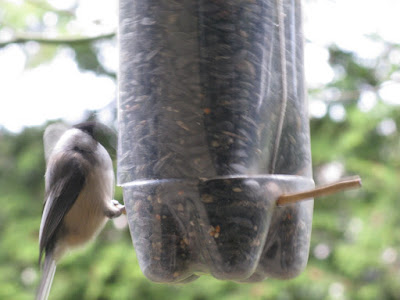Maybe I 'm exaggerating; let's downgrade that to, "several people have blogged about carpet beetles recently." That's here, on Tim Eisele's blog, and here, by David Brady, and my last Friday's post; "Do Beetles get hangovers?"
I'm bringing the discussion from Comments up to the front page; several issues merit further discussion.
1. Tim, Chalain and Snail are going to try the water and sugar tactics. I must add a couple of cautions.
Some time ago, I was investigating a few other of the tiny beasties; I can't remember which, at the moment. I discovered that, for the really small ones, I could trap them inside a droplet of water; they were not able to break the surface tension. With carpet beetles, they're not quite so vulnerable, but my little guy got stuck head-down in the droplet, until I siphoned a bit off with the corner of a paper towel. So, keep your droplets small.
Also, a drop of tap water, freshly drawn, has killed a few of the "tinies". Now, I use water that has been exposed to air for at least 24 hours, or rainwater from the garden. I imagine that it was the chlorination that caused the problem, and it evaporates off overnight.
2. Tim discussed our respective cameras and lenses on his blog.
Comparing their pictures to mine gives a good chance to see how much benefit I’m getting from the improvised macro lens made from a reversed SLR lens. David Brady (Insect Picture of the Day) uses a camera similar to mine (his is a Canon Powershot A640, I’m using an A95). I think that Wanderin’ Weeta is using a Canon A720 IS (another model in the same series, but with almost twice as much optical zoom as mine has). At any rate, we are probably all using cameras with broadly similar native optics to photograph essentially the same insect. The cameras with no supplementary macro lens, running only on their native macro mode, can get pictures that are good enough for identification of critters 2-3 mm long. But, there is a significant amount of blurring that is hazing out the details that are brought out using the macro lens. I’d say that the carpet beetles are about the smallest things that can be photographed decently with a stock consumer-grade camera, and a specialized macro lens gives pretty significant improvements at this size and smaller.Yes, Tim, I'm using the Canon A720. I've only had it a month, so am still experimenting with lenses. Blurring is a definite problem.
There is a Macro lens available for this camera; I have not yet investigated it, but will soon. I use the home-made lens I cobbled together (with a card tube, lenses pirated from an old pair of binoculars, and electrician's tape) for use with the beginner's Kodak.
And this is odd: I stacked the lenses anyhow, not knowing which was the best arrangement. When the photos came out ok, I taped the stack together. Call that #1. Later, I added a removable lens from a hand-held magnifying glass. #2. It worked. As well as could be expected, given the rudimentary equipment.
With the Canon, that arrangement makes no difference whatsoever; the camera set on macro mode, with nothing added gives me an identical result. But when I turn the #1 stack backwards, with #2 at the previous inner end, and the camera on full optical Zoom, I get a nice enlarged view.
I have since taped on another little lens, from an old slide projector, in the middle of the stack. I think it will help. And I'm playing with different lighting arrangements.
I look at better, more expensive cameras, and drool. Some day, I will get one. But for now, I am learning a lot about the effects of lighting, lenses, and settings; I am content.
3. About the beetles themselves.
From Tim, again:
Something that Wanderin’ Weeta pointed out is that there are slight depressions on the beetle underside that the legs can socket into, making a nearly flat surface. I expect that this is so that, when the beetle is getting knocked around (as commonly happens to beetles), the legs can be pulled out of harm’s way rather than getting snapped off.I found my lost photo of the leg sockets. (I thought I had deleted it by mistake, but it was just misfiled.)

The slots on either side, where the hind legs disappear to, are quite clear. But now, look at this:

The beetle was struggling madly to get himself flipped over onto his legs. The procedure involves rapid contortions and flapping of wings; after many failed attempts (much to the beetle's disgust, I am sure), I managed to catch him in the act. The photo is blurry, but you can see how the "slots" are really a division between the two major segments of the beetle's belly covering. Here they are separated quite widely, as he bends his body backwards. So he pulls the hind legs into this crack, much as a turtle does.
















































